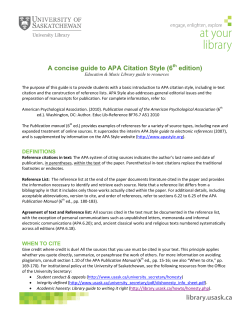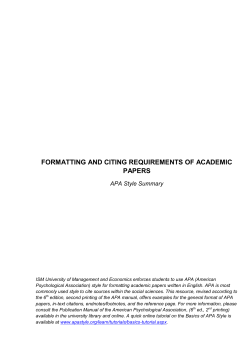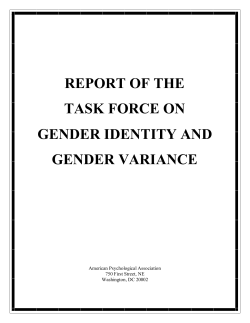
ADVANCED PRICING AGREEMENTS – AN INDUSTRY PERSPECTIVE Anders Oreby Hansen, Bech-Bruun, Denmark
ADVANCED PRICING AGREEMENTS – AN INDUSTRY PERSPECTIVE by Anders Oreby Hansen, Bech-Bruun, Denmark Anders Oreby Hansen, Bech-Bruun, Denmark BECH-BRUUN IN BRIEF Partnership 58 equity partners 16 non-equity partners Dedicated sector focus Full service law firm Large international network Offices in Copenhagen and Aarhus 525 staff members 2 260 lawyers 30 case handlers 74 partners Representation office in Shanghai ANDERS OREBY HANSEN 3 • Anders Oreby Hansen has over 20 years legal experience and represents US, EU and Scandinavian multinational groups and high-net-worth individuals investing or conducting business in/via Denmark. He advises on M&A tax planning, group restructurings, transfer pricing, international taxation and corporate consultancy matters. • Anders is an accomplished author and editor of numerous books and articles on taxation, including books on transfer pricing and international tax issues. He is chief editor of the commentary to Denmark's tax treaties and sits on the executive editorial boards of the leading Danish publications on international and Danish taxation and the executive tax boards of the Danish Bar Association and the Confederation of Danish Industry. AGENDA • What is an APA? • What can an APA achieve? • Procedural issues and Process • Content, Considerations and Observations • Disadvantages, advantages and requirements for success • APA trends / new developments 4 TRANSFER PRICING PROCESS Elements of a typical TP study: • Industry Analysis • Company Analysis • Functional / Process Analysis Documenting all stages • TP Methodology • Economic Analysis • For additional certainty: Advance Pricing Agreement 5 WHAT IS AN APA? (1) • Definition in OECD Guidelines An advance pricing arrangement (APA) is an arrangement that determines, in advance of controlled transactions, an appropriate set of criteria (…) for the determination of the transfer pricing for those transactions over a fixed period of time. (par. 4.123) 6 WHAT IS AN APA? (2) • The translation: An agreement between the taxpayer and the Internal Revenue Service (IRS) that binds the taxpayer to a defined Transfer Pricing Methodology (TPM) and that provides, in return, that if the conditions of the agreement are satisfied, then the IRS will not challenge on audit whether the specified transactions between the taxpayer and a related party covered by the agreement have been conducted at arm’s length. 7 WHAT IS AN APA? (3) • An Agreement • On the relevant facts • On what Transfer Pricing method is applicable • (On results of the application thereof) • Considering certain critical assumptions 8 WHAT IS AN APA? (4) • APA versions • Unilateral: Agreement between a legal entity or branch of a taxpayer and tax authority (national) • Bilateral: Agreement between two legal entities (or branches) of a taxpayer and two tax authorities of different countries (international) • Multilateral: Agreement between three (or more) legal entities (or branches) of a taxpayer and three (or more) tax authorities of different countries (international) • Preferred APA types? • Point of departure bilateral or multinational APA is preferred in the interest of sound tax administration, forum shopping and the elimination of any double taxation potential. Unilateral APA is practical in certain cases however. 9 SCOPE OF APAs • APAs identify the taxable entities, transactions and product lines covered by the agreements • There is no requirement that all related entities or all transactions or product lines among related parties be covered by an APA. • Example: UK manufacturer of several electronics products may request an APA between DK and UK only with regard to its sale of semiconductor products to one DK affiliate, even though the manufacturer has other DK affiliates and sells other products through its DK affiliates. • APAs specify the time period to which they apply • Minimum proposed term of 3-5 years, unless reason for shorter term • Expedited renewals for similar periods allowed • Rollbacks to prior open tax years are allowed(?) 10 CONTENT APA (1/2) • Scope • Intercompany transactions • Selection of transfer pricing methodology • Transfer price / remuneration method; domestic law / OECD TP, UN TP (target same result?) • Group companies involved • Country / countries involved • Organisation chart • Company background and history including financials, product, etc. 11 CONTENT APA (2/2) • Functional analysis (functions, risks & assets) • Comparables analysis • Financial years in scope, including information on (forecasted) P&Ls • Market & industry conditions • Critical assumptions (as to future events). Balance sheet adjustments for payables, receivables and inventory continue to be the most widely used adjustments • Compensating adjustments 12 APA TRANSFER PRICING METHODOLOGY (TPM) (1/2) • Transfer Pricing Methodology • Tax authorities agree on an approved TPM • Common TPMs in APAs, which TPMs are followed by most OECD member nations include: • • • Comparable Uncontrolled Price Method (CUP) Resale Price Method (RPM) Cost-Plus Method • Acceptance of other methods (formulary approaches) varies by country • • • 13 Reasonable Profit Split Method Comparable Profits Method (CPM) Cost Sharing APA TRANSFER PRICING METHODOLOGY (TPM) (2/2) • Transfer Pricing Methodology • Selection of an appropriate TPM requires consideration of the degree of certainty sought, administrability, the availability and sensitivity of supporting data, the tax results generated by the TPM, etc. • TPM provides a range of arm’s length results • Using approved TPM, results within range are acceptable • Compensating adjustments allowed when outside range 14 APA ROLLBACKS • Availability of rollbacks? • Varies from country to country • APAs can be applied to open tax years whenever feasible based on the consistency of the facts, law, and available records, except where a rollback of a unilateral APA request would decrease taxable income on a tax return filed for a taxable year not covered by the APA • Taxpayer may go for de facto rollback to unresolved transfer pricing issues of previous tax years at any time before the completion of APA negotiations • IRS may also act unilaterally to apply TPM from APA to prior years • Determination of rollback availability is within the discretion of the IRS official with jurisdiction over the taxable year subject to the rollback • For bilateral or multilateral APAs, rollback requests constitute applications for accelerated competent authority consideration 15 APA PROCESS STEPS (1/2) • Analysis of scope: What is it that should be achieved by filing an APA? • Due diligence – Do we really want it and do we know where we could end up? • Analysis • Submission of APA request / Taxpayer’s proposal • Evaluation & Negotiation: Agreement • Drafting, review & execution • Reporting • Renewal 16 APA PROCESS STEPS (2/2) • • • • • 17 Pre-filing meeting(s) to discuss case in general, including years, issues and companies to be covered, position of the taxpayer and test willingness of APA team to handle the matter Due diligence: ensure that APA request is appropriate for covered transactions and affiliates, discuss proposed TPMs and probability of agreement among competent authorities, clarify the APA process and what information will be required Filing of APA request, including years, issues and companies to be covered, functional analysis, proposed TP methodology, and economic analysis (including comparability / benchmarking analysis) Meeting, additional data gathering, analysis and settlement phase Drafting and concluding APA, including critical assumptions PROCEDURAL ISSUES • Time for filing: before year-end? Before tax return filing? Before business strategy change? Before reorganisation? • To whom is request to be addressed? Coordination with competent tax inspector and specialty group is to be handled properly • Authority of APA team vis-à-vis field auditors • Requests for bilateral APA made under Article 25 of Double Tax Treaty. Involvement of Competent Authority at the level of the Ministry of Finance • Development of case management plan with APA team including target date of completion of APA • Identify fees that do (or do not) apply for APA process 18 APA PROCESS - OVERVIEW • APA procedure in most countries 1. Pre-filing Phase 5. 2. Renewal Submission 4. Agreement 19 3. Audit & Discussion CONSIDERATIONS FOR APA • Is an APA the right choice? Volume of cross-border transactions Tax risk aversion vs. aggressive tax planning Litigation aversion / mitigation The complexity of transfer pricing issue The relationship with tax authorities The presence of cross-border transactions in high-risk jurisdictions • Level of uncertainty in macro-economic environment => in times of financial downturn, advanced certainty is often considered desirable for CFOs • The bear is sleeping – do we want to wake it up? • • • • • • 20 BENEFITS OF APAs (1/3) • Reduction or elimination of the risk of transfer pricing adjustments, penalties and risks as well as the risk of double taxation • Certainty of result • Predictability of tax treatment for APA covered transactions and a consequent increase in tax and management flexibility • If taxpayer complies with APA terms, IRS will not contest application of approved TPM to transactions, parties and time periods covered by APA • For bilateral or multilateral APAs, identified foreign tax authorities also will not contest TPM application • Avoidance of potential examination / controversy procedures 21 BENEFITS OF APAs (2/3) • Certainty of result - continued • Flexibility in adopting transfer pricing methods to deal with unique transactions, or a lack of usable comparables • Narrowing of recordkeeping obligations • Cost effective management of multiple pas and prospective years compare to the traditional examination process • Reduction of tax reserves on financial statements and often also administrative costs associated with transfer pricing compliance • An alternative dispute resolution mechanism for open / previous years • Valuation method determination / facts and outcomes • Address substance issues for the future? 22 BENEFITS OF APAs (3/3) • Assurance of no double taxation by IRS and foreign tax authority • Negotiating, rather than adversarial process • Allows flexibility and efficiency in arriving at appropriate TPM • Improved / enhanced relationship facilitator? • Often reduced compliance costs during APA life span 23 CAUTIONS REGARDING APAs (1/3) • Disclosure issues • APAs require extensive voluntary disclosure to the IRS • Concern about exposure to adjustments for open tax years (requires careful screening of information provided to the IRS) • Non-factual representations made during the APA process cannot be used as evidence in legal or administrative proceedings, unless the proceedings regard a tax year, transaction and person covered by a successfully completed APA • • No protection if otherwise discoverable, usable or admissible No protection for factual representations • Concern about disclosure of sensitive commercial data / trade secrets • Information submitted in APA process is considered tax return information and is protected from disclosure • Information submitted by a treaty partner is subject to treaty confidentiality requirements • Local concerns and traditions? 24 CAUTIONS REGARDING APAs (2/3) • Time and expense • Disclosure process is expensive and time-consuming • Disclosure generally more extensive than for private letter ruling but much less extensive than for transfer pricing examination • Other costs • Professional fees, expert opinion fees and employees salaries • Potential costs to change accounting systems to comply with TPM • Potential additional tax payments and interest for open tax years • User fees payable to the IRS – check locally • Critical assumptions • Will local tax authorities start a general audit following APA application? 25 CAUTIONS REGARDING APAs (3/3) Exposure is unavoidable Time-consuming / expensive process Strain on available resources No mandatory resolution Having to train the tax authorities at your expense – enhanced relationship? • Uncertain whether worth the investment • Information provided can be used against you • Confidentiality of information submitted not always clear • • • • • 26 REQUIREMENTS FOR SUCCESS • Integrity of process and people • Definitional issues to be addressed: APA is not necessarily evidence of what is arm’s length! • Experienced team(s) • Flexibility • Cooperation • Solution oriented approach • Do your homework before you contact the IRS! 27 APA TRENDS / NEW DEVELOPMENTS • New APA approaches being considered and benefits being rolled out • France: 13 years of experience with APAs (introduced in 1999), about 20 APAs per year completed, new relationship format between tax authorities and taxpayers as a result • Bilateral APAs seen as most useful approach to tackle difficult cross border cases • US pilot to start bilateral APA analysis on a bilateral basis rather than use of position papers • Broader use of APAs being explored by OECD • Certain countries seeing severe capacity and resource restrictions • Less flexibility to bespoke approaches • Local government disputes as to who is bound by APA (federal vs. state) 28 APA NUMBERS (1/3) • Danish tendencies: Number of pending and concluded APA files 29 Period Number of pending files Number of concluded files 2008 12 1 2009 12 3 2010 8 7 2011 9 4 APA NUMBERS (2/3) • US tendencies: • During 2011, 96 APA applications were filed and 42 APAs (plus 1 amended APA) were completed. • At year end, 445 APA requests1 were pending while only 305 of those were active (both saw an increase from 2010 when 400 pending requests and 243 active cases were reported). • In 2011, fewer applications were filed and fewer APAs were completed than in 2010. The average time required to complete an APA increased (from 37.2 months in 2010 to 40.7 months in 2011). • Unilateral APA requests dropped more than 50 %, from 46 in 2010 to 20 in 2011.2 • The number of recommended negotiating position papers completed decreased from 58 in 2010 to 47 in 2011. 1. The 445 pending requests include dollar filings as well as other cases that have not yet been assigned to a team leader. 2. This decrease may reflect, in part, decreased willingness by the AA program to accept unilateral APA requests. Last year’s APA report, Announcement 2011-12, stated, “To date no request for a unilateral APA has been rejected on the sole basis that the submission sought a unilateral rather than a bilateral or multilateral process.” That statement was not in this year’s APA report. 30 APA NUMBERS (3/3) • US tendencies continued: • In 2011, 26 APAs were completed with companies having a foreign parent while 16 were completed with companies having a US parent. • The sale of tangible property in the US continued to be the most common type of related party transaction covered by an APA in 2011. The Comparable Profits Method (CPM), using an operating margin as the profit level indicator (PLI), was once again the Transfer Pricing Method (TPM) most commonly used in the competed APAs. Also, the CPM using a PLI based on the ratio of operating profit to total services cost continued to be the most commonly used TPM for APAs covering services in 2011. • Compustat continues to be the most frequently used database for finding comparable company information. 31 Questions ? 32 CONTACT TAX Anders Oreby Hansen Partner · Copenhagen T +45 72 27 36 02 M +45 25 26 36 02 E aoh@bechbruun.com www.bechbruun.com Copenhagen Langelinie Allé 35 2100 Copenhagen Ø Aarhus Frue Kirkeplads 4 8100 Aarhus C Shanghai 83 Loushanguan Road, suite 2630, 26/F Shanghai T +45 72 27 00 00 F +45 72 27 00 27 E info@bechbruun.com
© Copyright 2025




















